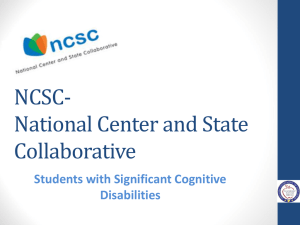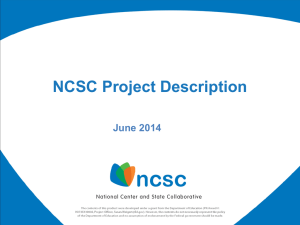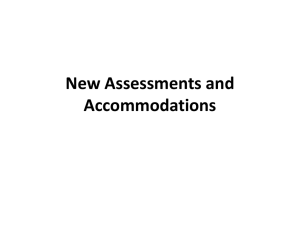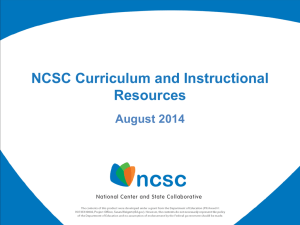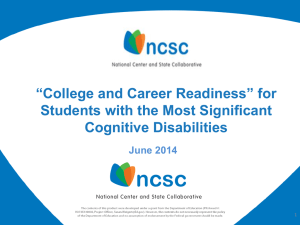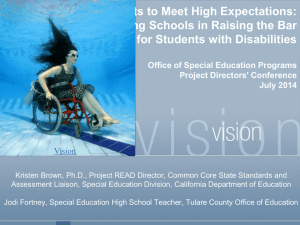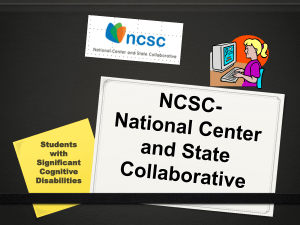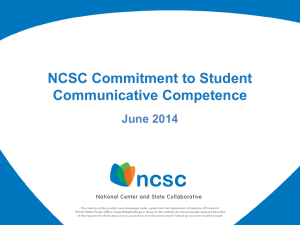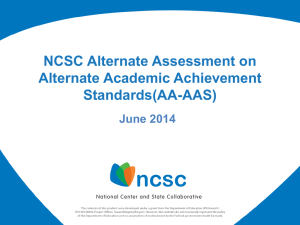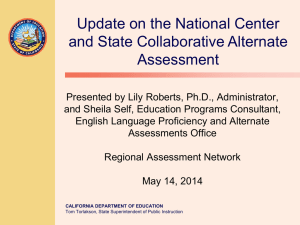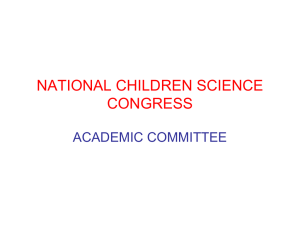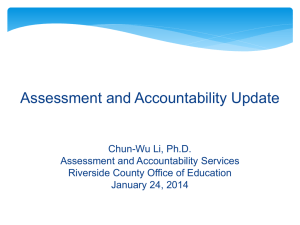PPT on the NSCS Alternate Assessment
advertisement
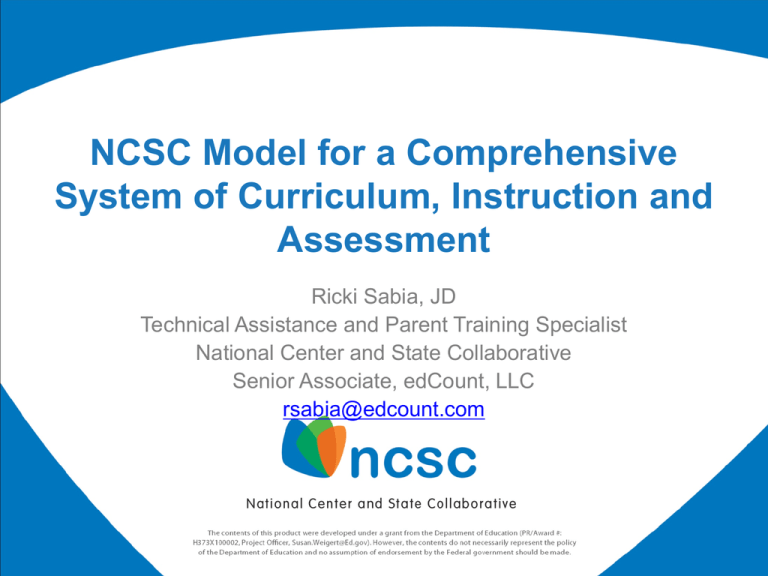
NCSC Model for a Comprehensive System of Curriculum, Instruction and Assessment Ricki Sabia, JD Technical Assistance and Parent Training Specialist National Center and State Collaborative Senior Associate, edCount, LLC rsabia@edcount.com NCSC Background • In 2010, with funding from the U.S. Department of Education the National Center and State Collaborative (NCSC) began developing a new alternate assessment in math and ELA to be completed by the 2014-15 school year* • 24 states and five national centers are working together in NCSC http://www.ncscpartners.org/ • NCSC is also developing curriculum/instructional resources based on Common Core State Standards (CCSS) that can be used in any state https://wiki.ncscpartners.org *states may have different implementation timelines for NCSC assessment 2 NCSC Partner States 3 Importance of NCSC Resources to Parent Centers in All States • Free online curriculum and instruction resources support access to standards based education for students with significant cognitive disabilities at https://wiki.ncscpartners.org • Parent resources describe the NCSC curriculum and instructional resources, the assessment and explain related issues at http://www.ncscpartners.org/resources • Much state discretion- Parent Centers can use the resources to understand NCSC, follow up with SEA and provide input on state decisions NCSC’s Value in States Without CCSS • The main focus of any set of academic standards addresses similar content in math and ELA (e.g. equations, elements of fiction) • The NCSC resources are not meant to “be” the curriculum – they are models of curriculum and instructional resources that happen to be based on the CCSS • These models also demonstrate how to develop curriculum and instructional resources based on whatever standards a state is using • The richness of the NCSC resources for students with significant cognitive disabilities and their usefulness for professional development are valuable in any state 5 Key College and Career Ready Skills Important for ALL students including those with significant cognitive disabilities: • Communicative competence • Social skills to function well in small groups • Independent and team work skills • Problem Solving • Reading/writing/math • Skills for identifying and requesting supports 6 NCSC Philosophy A well-designed state assessment alone is insufficient for college, career and community readiness. To achieve these goals, an Alternate Assessment system requires: Curricular & instructional framework Teacher resources and professional development Communicative Competence as a priority 7 NCSC Curriculum and Instructional Resources https://wiki.ncscpartners.org 8 Quality Indicators for Instructional Resources • Promote Common Core State Standards • Set high expectations for all students • Apply principles of Universal Design for Learning (UDL) • Apply evidence-based teaching practices for students with the most significant cognitive disabilities Learning Progressions Framework (LPF) • Shows the steps students typically take to make progress in a content area (e.g. math) to get deeper, broader, more sophisticated understanding • Represents the essential core concepts and processes learned in a content area (sometimes called the “big ideas”) Hess, Karin K., (December 2011). Learning Progressions Frameworks Designed for Use with the Common Core State Standards in English Language Arts & Literacy K-12. 11 Core Content Connectors (CCCs) • Using the Learning progressions framework NCSC identified the key knowledge and skills (“the big ideas”) from the Common Core State Standards needed at each grade to make progress in later grades. • These “big ideas” were then broken down into teachable and assessable segments of content called CCCs • CCCs operate as a starting point for instruction based on the Common Core State Standards 12 CCC Example CCSS- Read closely to determine what the text says explicitly and to make logical inferences from it; cite specific textual evidence when writing or speaking to support conclusions drawn from the text. CCC- Ask and answer questions* about key details in a text. *Instead of an oral or written response, some students may use picture symbols, character figures and props, etc. 13 Instructional Families 14 • Put related CCCs into families showing how they develop and interact across all the grades, across a grade band (e.g. Elementary School) and within a grade • Helps educators see what is coming next so they can prepare students for future learning • Can be used to inform standards based IEP goal writing Grade-span Learning Target from the Learning Progression Frameworks 15 Instructional Families for Data Analysis I (K-4) Reference to related CCSS Distribution of CCCs by Instructional Families an grade Element Cards 16 Curriculum Resource (CR) Guides for Math and ELA Topics • Provide guidance and sample materials for teaching the CCSS to students with the most significant cognitive disabilities; • Provide ways to promote college and career readiness • Provide examples for differentiating instruction for a wide range of student needs (UDL tables) Example of UDL Table in ELA Curriculum Resource Guide Universal Design for Learning (UDL) Units and Lessons for more info on UDL see www.udlcenter.org • Purpose: to model how to plan for ALL students using the principles of UDL (multiple means of engagement, representation and expression) and provide additional considerations for Emerging Readers and Emerging Communicators • For use in general education and special education classes-great for co-teaching and collaborative planning Math/ Language Activities for Scripted Systematic Instruction (MASSIs and LASSIs) • Provide more intensive systematic instruction on key concepts and symbols in all educational settings, including general education classrooms • Incorporate evidence-based instruction from research, including faded prompting • Provide teaching scripts for teachers who may not have a lot of training in systematic instruction • Are designed with graduating levels of difficulty – starting with the first steps of teaching the content to students with little or no understanding of 20 the content Professional Development • Communities of Practice in partner states received professional development about the curriculum and instructional resources via webinars that are publicly available at http://www.ncscpartners.org/resources-coppresentations • States will also have access to interactive professional development modules 21 Assessment NCSC assessments are in math and ELA, which includes both reading and writing, for grades 3-8 and 11 Note: Info on the assessment slides could change after pilot testing is complete Format • Approximately 30 items for each subject • These 30 items will cover approximately 10 CCCs • Most of the assessment items ask the student to select the correct response (e.g. multiple choice). • Some items will require the student to construct a response (e.g. write a short answer or use an alternate way to respond e.g. picture symbols) 23 Length of Assessment • Expected testing time will be approximately 1.5 – 2 hours for each assessment (math and ELA.) • Each student’s assessment can be completed in multiple smaller time slots over a 2 month period to meet the student’s needs 24 Technology • This will be an online testing program. • Some students will use the online testing program directly on the computer. • For other students, the teacher may print out testing materials and enter student responses into the computer. 25 26 Assessment Participation Guidelines • For students with pervasive significant cognitive disabilities whose IEP goals and instruction are based on Common Core State Standards and who need extensive direct individualized instruction and substantial supports • The IEP team will determine annually whether a student will take assessment Parent Resources http://www.ncscpartners.org/resources 27 Parent Resources (as of September 4, 2014) • • • • NCSC Project Description NCSC Project Description One Page NCSC Diagram and Explanation NCSC Model of Curriculum, Instruction and Assessment • NCSC Alternate Assessment FAQs • NCSC Commonly Asked Parent Questions • NCSC IEP Team Guidance For Participation in Alternate Assessment Parent Resources • NCSC College and Career Readiness • NCSC College Career Ready (CCR) Policy Paper Summary • NCSC Communicative Competence • NCSC Newsletter and Website Information for Parents • NCSC Discussion Points with Research • NCSC Value in States Without Common Core State Standards * There are also PowerPoints on the main topics and one that is comprehensive Example: Guidance for IEP Teams on Assessment Participation Decisions It is essentially the same Guidance for IEP Teams that educators receive, but more parent friendly: • Removes some background information about the project which is already in the project summary. • Provides the criteria for participation using the same language, but side bar provides definitions for the terms • Explains (in parentheses) some terms in the list of information not to be considered for the assessment decision (e.g. educational setting) • FAQs are more parent focused, e.g. have placeholder for info on diploma policies and process for disagreeing with IEP team assessment decision Sample text from the document
